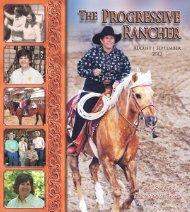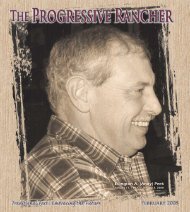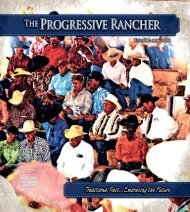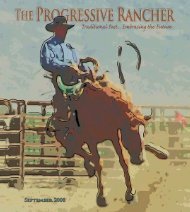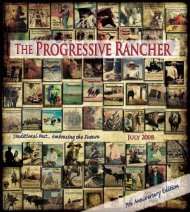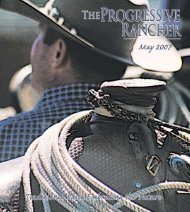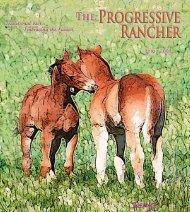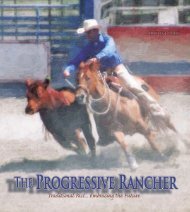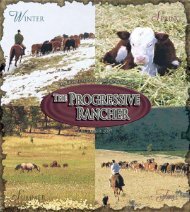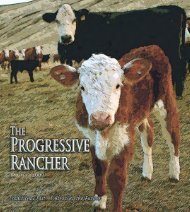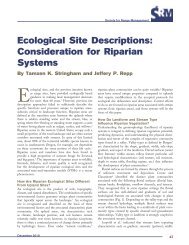fallon Bull Sale - The Progressive Rancher Magazine
fallon Bull Sale - The Progressive Rancher Magazine
fallon Bull Sale - The Progressive Rancher Magazine
Create successful ePaper yourself
Turn your PDF publications into a flip-book with our unique Google optimized e-Paper software.
COW CAMP<br />
Chatter<br />
Ron Torell, Long-Standing Educator and Advocate of Agriculture<br />
Holstein bull by the name of Potter recently joined a small but elite group<br />
A of dairy sires that have produced and sold over one million units of semen.<br />
This elite group of bulls could be titled the “<strong>Bull</strong>s of the Century.” <strong>The</strong>ir genes roam<br />
herds around the globe. Some estimate a million unit bull would have more than<br />
150,000 daughters and 2.3 million granddaughters and would be responsible for 15%<br />
of the DNA in today’s U.S. dairy cows.<br />
<strong>The</strong> U.S. beef industry maintains a wide variation in their genetic pool with several<br />
breeds of cattle being utilized. Grass is harvested by our four-legged employees from the<br />
arid rangelands of the west to the lush grasslands of the east and the hot, humid areas of the<br />
south. Conversely, most of the nation’s dairy cows are confinement fed. Meals are delivered<br />
to them in a balanced total mixed ration. For this reason the dairy industry can single trait<br />
select and maintain a tight genetic base. <strong>The</strong> beef industry will never have the tight genetic<br />
base that is seen in the dairy industry. In order to maintain reproductive success with limited<br />
feed resources beef cows in arid climates are generally smaller framed, lower in milk<br />
production, and hardy. Missed income opportunity would result if this type of cow was<br />
used on more lush grasslands where perhaps a larger framed, higher milking cow could be<br />
reproductively successful .<br />
Many feedlot operators prefer to feed Holstein steers over beef breeds because of the<br />
tight genetic makeup of the breed. <strong>The</strong>y know what to expect for feed conversions, average<br />
daily gain, days on feed, breakeven, percent choice, yield grades, etc. Holstein steers<br />
perform at a lower level than beef animals but they are consistent. <strong>The</strong> lower performance<br />
is factored into the purchase price with confidence and accuracy. Because of this predictability,<br />
fewer pens of fat Holstein steers close out in the red than with pens of beef cattle.<br />
Beef steers are all over the board in performance primarily due to genetic makeup even<br />
within a breed. Unpredictable best sums it up for beef cattle.<br />
Five to seven percent of the nation’s beef herds are bred artificially. Many of these<br />
BULL POWER<br />
artificially bred cows are registered seed stock with the bull offspring going to the commercial<br />
cattleman. Over 90% of dairy cattle are artificially inseminated with their female<br />
offspring going into commercial production. <strong>The</strong> bulls used for A.I. are selected primarily<br />
for the single trait of milk production and mammary system structure to support added milk<br />
production. Dairy cows remain in production fewer years than beef cows. Generations are<br />
turned over faster accelerating genetic improvement. This is the difference in the tremendous<br />
progress the dairy cow has made in their single trait of milk versus the slow progress<br />
the beef cow has made in multiple and low heritability traits. Just as the dairy industry<br />
is producing more milk with fewer cows the beef industry is producing more pounds of<br />
beef with fewer brood cows. <strong>The</strong>se similarities can be attributed to improved genetics and<br />
management practices.<br />
Don Trimmer, director of beef programs for Accelerated Genetics, agrees with the<br />
wide variability of beef cattle compared to the dairy industry. He points out that the number<br />
of beef breeds that are making an impact are substantially lower than there were ten<br />
years ago. <strong>The</strong> American Angus Association registers more cattle than all other breeds<br />
combined. <strong>The</strong> dominance of Angus genetics in the commercial cowherd has helped to<br />
reduce some of the variation in the nation’s beef cowherd, though it may be more from a<br />
phenotypic standpoint. In many areas of the country, the “rainbow” herds of the past can’t<br />
be found. <strong>The</strong> majority are solid black or red cows with some baldies. If you look at the data<br />
of most widely used breeds, it continues to show 60-70% Angus or Angus cross bulls. <strong>The</strong><br />
volume of semen sold on beef bulls like EXT, New Design 036, Traveler and Focus have<br />
had a huge impact on the genetics of the commercial cowherd.<br />
Experts agree that the dairy industry may be on the verge of being inbred yet point<br />
out that the dairy industry may hold the key to decoding the bovine genome. Million unit<br />
bulls such as Potter are genetic landslides for this decoding process because they appear<br />
in so many pedigrees. <strong>The</strong>ir family tree serves as a guide and base in identifying the most<br />
important genes, an ultimate reference point for DNA technology.<br />
Beef cattle genetic advancement in the area of uniformity and predictability has and<br />
will continue to move at a slower pace than what the dairy industry has been able to accomplish.<br />
This should not discourage the beef industry from working toward the goal of<br />
producing uniform and predictable cattle. This can be achieved by incorporating quality<br />
registered bulls into breeding programs and by using, when applicable, technology such as<br />
artificial insemination selecting high accuracy EPD bulls for multiple traits.<br />
That’s enough for this month. As always, if you would like to discuss this article or<br />
simply want to talk cows, do not hesitate to contact me at 775-385-7665 or rtbulls@frontier.<br />
com.<br />
RT Range-ready A.I. Sired Angus <strong>Bull</strong>s, Accelerated Genetics Semen,<br />
Custom Artificial Insemination & Ranch Management Consulting<br />
Ron & Jackie Torell ♦ 775-385-7665 ♦ rtbulls@frontier.com<br />
www.progressiverancher.com <strong>The</strong> <strong>Progressive</strong> <strong>Rancher</strong><br />
February 2011 5



